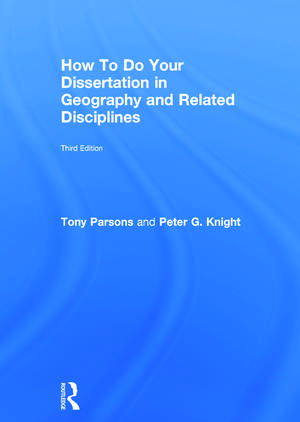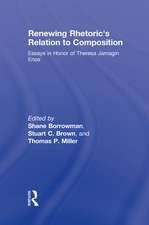How To Do Your Dissertation in Geography and Related Disciplines
Autor Tony Parsons, Peter G Knighten Limba Engleză Hardback – 27 feb 2015
This new third edition continues the tradition of friendly, well-informed but informal support, and continues to focus on answering the specific questions that students typically ask at each stage of the project. The new edition brings the text completely up to date by taking into account changes within the discipline and changes in the ways that students work. New digital media, social networking, mobile technology, e-journals, anti-plagiarism software, ethics approval rules and risk assessments are among the issues that this new edition takes into account. The new edition also broadens the book’s appeal by extending its coverage of the wide range of different approaches to geographical research, with expanded coverage of qualitative research, Geographic Information Systems, and new approaches to research design in both physical and human geographies
| Toate formatele și edițiile | Preț | Express |
|---|---|---|
| Paperback (1) | 297.75 lei 3-5 săpt. | +55.22 lei 4-10 zile |
| Taylor & Francis – 17 feb 2015 | 297.75 lei 3-5 săpt. | +55.22 lei 4-10 zile |
| Hardback (1) | 1015.97 lei 6-8 săpt. | |
| Taylor & Francis – 27 feb 2015 | 1015.97 lei 6-8 săpt. |
Preț: 1015.97 lei
Preț vechi: 1367.28 lei
-26% Nou
Puncte Express: 1524
Preț estimativ în valută:
194.43€ • 202.24$ • 160.51£
194.43€ • 202.24$ • 160.51£
Carte tipărită la comandă
Livrare economică 15-29 aprilie
Preluare comenzi: 021 569.72.76
Specificații
ISBN-13: 9780415732352
ISBN-10: 0415732352
Pagini: 204
Ilustrații: 13 black & white illustrations, 5 black & white tables, 13 black & white line drawings
Dimensiuni: 174 x 246 mm
Greutate: 0.52 kg
Ediția:Revised
Editura: Taylor & Francis
Colecția Routledge
Locul publicării:Oxford, United Kingdom
ISBN-10: 0415732352
Pagini: 204
Ilustrații: 13 black & white illustrations, 5 black & white tables, 13 black & white line drawings
Dimensiuni: 174 x 246 mm
Greutate: 0.52 kg
Ediția:Revised
Editura: Taylor & Francis
Colecția Routledge
Locul publicării:Oxford, United Kingdom
Public țintă
UndergraduateCuprins
1. Introduction 2. What is a (good) dissertation and why do I have to do one? 3. When should I start and how long will it take? 4. What shall I do it on? 5. Research design 1 - what approach should I take? 6. Research design 2 - exactly how should I do this project? 7. What kind(s) of data do I need and how do I get them? 8. What amount of data do I need, and what can I do with my data? 9. How should I write up my dissertation? 10. Help! It's all gone horribly wrong. What can I do? 11. How will it be marked?
Notă biografică
Tony Parsons is professor in the Department of Geography at Sheffield University. His research interests are in Hillslopes, dryland geomorphology and soil erosion.
Peter G. Knight is a senior lecturer in Geography at Keele University. He carries out research in glaciology based on Arctic fieldwork and laboratory experiments. His research interesets also include the relationships between art, science and goegraphy.
Peter G. Knight is a senior lecturer in Geography at Keele University. He carries out research in glaciology based on Arctic fieldwork and laboratory experiments. His research interesets also include the relationships between art, science and goegraphy.
Descriere
This book provides undergraduates with a step-by-step guide to successfully carrying out an independent research project or dissertation. The book addresses each stage of the project by answering the questions that a student is likely to ask as the work progresses from choosing the subject area and planning the data collection through to producing illustrations and writing the final report. Most undergraduates in Geography and related disciplines are required to undertake individual projects as part of their degree course; this book is a source of constructive, practical advice.
This new third edition continues the tradition of friendly, well-informed but informal support, and continues to focus on answering the specific questions that students typically ask at each stage of the project. The new edition brings the text completely up to date by taking into account changes within the discipline and changes in the ways that students work. New digital media, social networking, mobile technology, e-journals, anti-plagiarism software, ethics approval rules and risk assessments are among the issues that this new edition takes into account. The new edition also broadens the book’s appeal by extending its coverage of the wide range of different approaches to Geographical research, with expanded coverage of qualitative research, Geographic Information Systems, and new approaches to research design in both physical and human geographies
This new third edition continues the tradition of friendly, well-informed but informal support, and continues to focus on answering the specific questions that students typically ask at each stage of the project. The new edition brings the text completely up to date by taking into account changes within the discipline and changes in the ways that students work. New digital media, social networking, mobile technology, e-journals, anti-plagiarism software, ethics approval rules and risk assessments are among the issues that this new edition takes into account. The new edition also broadens the book’s appeal by extending its coverage of the wide range of different approaches to Geographical research, with expanded coverage of qualitative research, Geographic Information Systems, and new approaches to research design in both physical and human geographies


















